上一篇教程写的实在是有点看不下去,重新写一个吧。
开始
导入相关包
1
2
3
4
5
| %matplotlib inline
import matplotlib.pyplot as plt
import tensorflow as tf
import numpy as np
from sklearn.metrics import confusion_matrix
|
获取MNIST数据集
1
2
| from tensorflow.examples.tutorials.mnist import input_data
data = input_data.read_data_sets("data/MNIST_data/", one_hot=True)
|
MNIST的信息
1
2
3
4
| print("Size of:")
print("- Training-set:\t\t{}".format(len(data.train.labels)))
print("- Test-set:\t\t{}".format(len(data.test.labels)))
print("- Validation-set:\t{}".format(len(data.validation.labels)))
|
Size of:
- Training-set: 55000
- Test-set: 10000
- Validation-set: 5000
1
2
3
4
| print(data.test.labels[0:5, :])
data.test.cls = np.array([label.argmax() for label in data.test.labels])
print(data.test.cls)
print(data.test.cls[0:5])
|
[[0. 0. 0. 0. 0. 0. 0. 1. 0. 0.]
[0. 0. 1. 0. 0. 0. 0. 0. 0. 0.]
[0. 1. 0. 0. 0. 0. 0. 0. 0. 0.]
[1. 0. 0. 0. 0. 0. 0. 0. 0. 0.]
[0. 0. 0. 0. 1. 0. 0. 0. 0. 0.]]
[7 2 1 ... 4 5 6]
[7 2 1 0 4]
1
2
3
4
5
6
7
8
|
img_size = 28
img_size_flat = img_size * img_size
img_shape = (img_size, img_size)
num_classes = 10
|
1
2
3
4
5
6
7
8
9
10
11
12
13
14
15
16
17
18
19
|
def plot_images(images, cls_true, cls_pred=None):
assert len(images) == len(cls_true) == 9
fig, axes = plt.subplots(3,3)
fig.subplots_adjust(hspace=0.3, wspace=0.3)
for i, ax in enumerate(axes.flat):
ax.imshow(images[i].reshape(img_shape), cmap='binary')
if cls_pred is None:
xlabel = "True: {0}".format(cls_true[i])
else:
xlabel = "True: {0}, Pred: {1}".format(cls_true[i],cls_pred[i])
ax.set_xlabel(xlabel)
ax.set_xticks([])
ax.set_yticks([])
plt.show()
|
1
2
3
| images = data.test.images[0:9]
cls_true = data.test.cls[0:9]
plot_images(images=images, cls_true=cls_true)
|
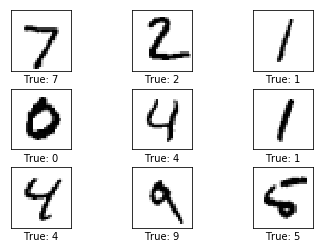
初始Tensorflow模型
1
2
3
4
5
6
|
x = tf.placeholder(tf.float32, [None, img_size_flat])
y_true = tf.placeholder(tf.float32, [None, num_classes])
y_true_cls = tf.placeholder(tf.int64, [None])
|
除了上面定义向模型提供输入数据的 placeholder,还有一些由 Tensorflow 训练获得的值。
这两个其实不一样,placeholder是原始数据,训练的时候不变。Variable 是训练的时候的哪些变量。
1
2
3
4
|
weights = tf.Variable(tf.zeros([img_size_flat, num_classes]))
biases = tf.Variable(tf.zeros([num_classes]))
|
定义线性模型,logits = x * weights + biases , x 是 [num_images, img_size_flat], weights 是 [img_size_flat, num_classes], biases 是 [num_classes], 所以 logits 是一个 [num_images, num_classes]。
换句话说, 每一个images,都有一个对应的class
1
2
3
4
| logits = tf.matmul(x, weights) + biases
y_pred = tf.nn.softmax(logits)
y_pred_cls = tf.argmax(y_pred, axis=1)
|
1
2
3
4
5
|
cross_entropy = tf.nn.softmax_cross_entropy_with_logits_v2 \
(logits=logits, labels=y_true)
cost = tf.reduce_mean(cross_entropy)
|
1
2
3
4
5
6
7
8
9
10
11
|
optimizer = tf.train.GradientDescentOptimizer(learning_rate=0.5)\
.minimize(cost)
correct_prediction = tf.equal(y_pred_cls, y_true_cls)
accuracy = tf.reduce_mean(tf.cast(correct_prediction, tf.float32))
|
TensorFlow 跑两步
1
2
3
4
5
6
| session = tf.Session()
session.run(tf.global_variables_initializer())
batch_size = 100
|
1
2
3
4
5
6
| def optimize(num_iterations):
for i in range(num_iterations):
x_batch, y_true_batch = data.train.next_batch(batch_size)
feed_dict_train = {x : x_batch,
y_true: y_true_batch}
session.run(optimizer, feed_dict=feed_dict_train)
|
1
2
3
| feed_dict_test = {x: data.test.images,
y_true: data.test.labels,
y_true_cls: data.test.cls}
|
1
2
3
4
5
|
def print_accuracy():
acc = session.run(accuracy, feed_dict=feed_dict_test)
print("测试集准确率: {0:.1%}".format(acc))
print_accuracy()
|
测试集准确率: 9.8%
1
2
3
4
5
6
7
8
9
10
11
12
13
14
15
16
17
18
19
20
21
22
| def print_confusion_matrix():
cls_true = data.test.cls
cls_pred = session.run(y_pred_cls, feed_dict=feed_dict_test)
cm = confusion_matrix(y_true=cls_true,
y_pred=cls_pred)
print(cm)
plt.imshow(cm, interpolation='nearest', cmap=plt.cm.Blues)
plt.tight_layout()
plt.colorbar()
tick_marks = np.arange(num_classes)
plt.xticks(tick_marks, range(num_classes))
plt.yticks(tick_marks, range(num_classes))
plt.xlabel('Predicted')
plt.ylabel('True')
plt.show()
print_confusion_matrix()
|
[[ 980 0 0 0 0 0 0 0 0 0]
[1135 0 0 0 0 0 0 0 0 0]
[1032 0 0 0 0 0 0 0 0 0]
[1010 0 0 0 0 0 0 0 0 0]
[ 982 0 0 0 0 0 0 0 0 0]
[ 892 0 0 0 0 0 0 0 0 0]
[ 958 0 0 0 0 0 0 0 0 0]
[1028 0 0 0 0 0 0 0 0 0]
[ 974 0 0 0 0 0 0 0 0 0]
[1009 0 0 0 0 0 0 0 0 0]]

1
2
3
4
5
6
7
8
9
10
11
| def plot_example_errors():
correct, cls_pred = session.run([correct_prediction, y_pred_cls],
feed_dict=feed_dict_test)
incorrect = (correct == False)
images = data.test.images[incorrect]
cls_pred = cls_pred[incorrect]
cls_true = data.test.cls[incorrect]
plot_images(images[0:9],
cls_true[0:9],
cls_pred[0:9])
plot_example_errors()
|

1
2
3
4
5
6
7
8
9
10
11
12
13
14
15
16
17
| def plot_weights():
w = session.run(weights)
w_min = np.min(w)
w_max = np.max(w)
fig, axes = plt.subplots(3, 4)
fig.subplots_adjust(hspace=0.3, wspace=0.3)
for i, ax in enumerate(axes.flat):
if i<10:
image = w[:, i].reshape(img_shape)
ax.set_xlabel("Weights: {}".format(i))
ax.imshow(image, vmin=w_min, vmax=w_max, cmap='seismic')
ax.set_xticks([])
ax.set_yticks([])
plt.show()
plot_weights()
|
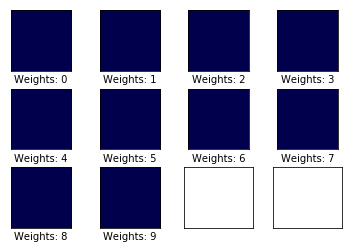
跑一步
1
2
3
4
| optimize(num_iterations=1)
print_accuracy()
plot_example_errors()
plot_weights()
|
测试集准确率: 11.7%
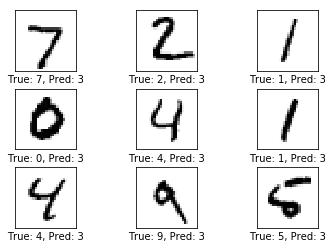

跑10步
1
2
3
4
| optimize(num_iterations=9)
print_accuracy()
plot_example_errors()
plot_weights()
|
测试集准确率: 81.1%

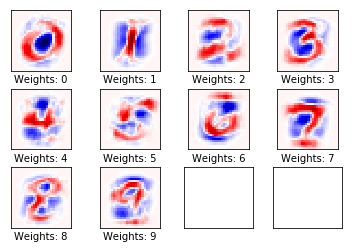
跑1000步
1
2
3
4
| optimize(num_iterations=990)
print_accuracy()
plot_example_errors()
plot_weights()
|
测试集准确率: 91.9%

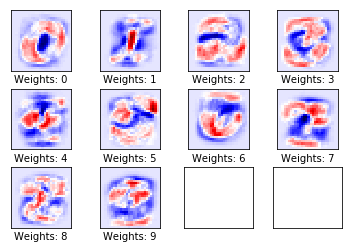
1
| print_confusion_matrix()
|
[[ 958 0 3 2 0 6 8 1 2 0]
[ 0 1094 2 2 1 1 4 2 29 0]
[ 5 7 914 18 13 4 11 10 44 6]
[ 3 0 15 917 0 28 3 11 27 6]
[ 1 1 6 1 922 0 9 2 12 28]
[ 9 1 4 40 10 761 17 6 37 7]
[ 11 3 6 1 12 12 906 1 6 0]
[ 3 7 21 8 7 1 0 944 6 31]
[ 4 4 5 15 9 22 9 8 894 4]
[ 9 4 3 9 51 6 0 27 16 884]]

结论
线性模型的准确率约为: 91.9% ,堪忧啊,还要再搏一搏。










